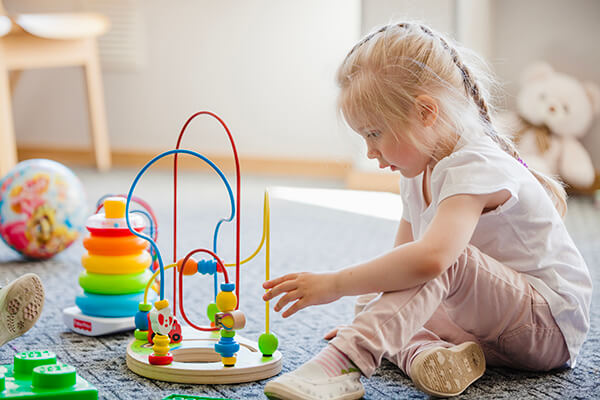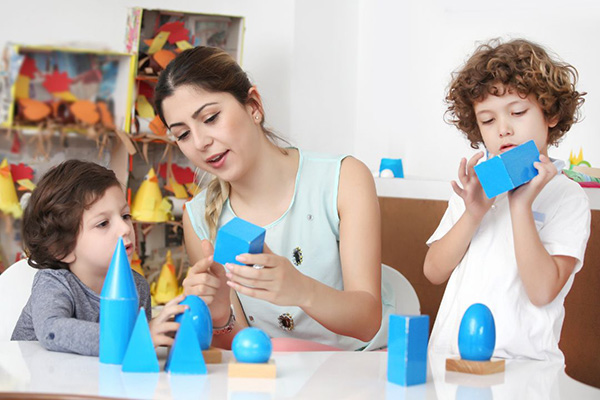As parents, we want to ensure our children have the best possible start in life, and for many families, choosing a Montessori education is an important part of that journey. With its emphasis on independence, hands-on learning, and respect for the child’s natural development, Montessori principles are invaluable in shaping how children learn and grow. But Montessori doesn’t end at the school door. Parents can play an equally important role in supporting their child’s education at home, especially in a bilingual environment.
One of the key ideas of Montessori education is fostering independence and helping children develop a sense of agency in their world. At the heart of this is creating an environment that is accessible, organized, and respectful of the child’s developmental needs. In this article, we’ll explore practical ways to make your home a Montessori-friendly, bilingual space that encourages learning, exploration, and growth in both Spanish and English.
1. Organize Your Home to Support Independence
One of the fundamental aspects of Montessori education is giving children the opportunity to do things for themselves. To achieve this, your home needs to be organized in a way that promotes easy access to materials and activities. In a bilingual environment, this is especially important, as it helps children feel comfortable navigating both languages and cultures.
A few tips to get started:
- Child-Sized Furniture: Ensure that furniture, shelves, and counters are scaled to your child’s size. This could mean using small tables and chairs, or low shelves where toys, books, and learning materials are easily within reach. When children can independently choose and return their own materials, they develop a sense of order and responsibility.
- Accessible Bilingual Materials: In a bilingual home, it’s important to make both languages available in everyday situations. Labeling items around the house in both Spanish and English can be a fun way to expose children to new vocabulary. For instance, a label on the door can read “Puerta” on one side and “Door” on the other. This simple practice helps children become familiar with both languages in context.
- Organized Spaces: Whether it’s for play or learning, creating clearly designated areas in your home for specific activities is key. A space for arts and crafts, a reading corner, or a small kitchen station for cooking—each of these can be set up to encourage both language development and autonomy. You can even include books and materials in both languages in each of these spaces to ensure that your child has constant exposure to Spanish and English.
2. Scaled-Down Tools for Practical Life Skills
Montessori education emphasizes practical life activities—skills that children use in daily life, such as dressing, cleaning, cooking, and caring for the environment. These activities are not only essential for building independence, but they also serve as a foundation for learning in other areas, such as math, science, and language.
To foster your child’s participation in daily routines, consider providing child-sized versions of everyday tools and materials. In a bilingual Montessori home, these tools can also become an opportunity for language learning.
Examples include:
- Child-Sized Kitchen Tools: Children can help with meal prep by using scaled-down kitchen tools like small knives, cutting boards, or measuring cups. This hands-on experience fosters both fine motor skills and a sense of accomplishment. As you cook together, you can teach your child the names of foods and cooking actions in both Spanish and English.
- Cleaning Supplies: In Montessori education, children learn to care for their environment, and cleaning is an essential life skill. Provide child-friendly brooms, dustpans, and mop sets so your child can help clean up after activities. You can also teach them phrases like “limpiar” (to clean) and “barrer” (to sweep) in Spanish while they work.
- Dressing Skills: Let your child practice dressing themselves with clothing that is easy to manage. Velcro shoes, elastic waistbands, and simple buttons help your child feel confident and capable. You can incorporate both languages by talking them through the process: “Pon tus zapatos” (Put on your shoes), or “Abre los botones” (Open the buttons).
3. Create a Bilingual Reading and Language Zone
One of the most valuable gifts you can give your child is a love for reading and language. Creating a bilingual language zone in your home will help expose them to both languages in a natural and immersive way. This area could be a bookshelf, a cozy reading corner, or even a wall with language-learning posters.
Consider the following ideas:
- Bilingual Books: Choose books that are written in both Spanish and English or bilingual storybooks. Reading aloud in both languages helps your child pick up vocabulary and sentence structure naturally. Look for books that have themes relevant to their age and interests, and don’t be afraid to read the same book multiple times—repetition is key in language learning.
- Language Immersion through Songs and Rhymes: Singing songs and rhymes in both languages is another fun way to help your child learn. Nursery rhymes and simple songs like “Twinkle, Twinkle, Little Star” can be found in both languages and are a great way to practice vocabulary and rhythm.
- Interactive Language Learning: Engage your child in simple games or conversations in both languages. For example, you might play “Simon Says” (“Simón dice”) or teach them basic greetings, colors, and numbers in both languages. The goal is to make language learning fun and a natural part of their daily routine.
4. Encourage Movement and Outdoor Exploration
The Montessori method encourages children to be active and to explore their world through movement. The outdoor environment is a fantastic place for children to learn, whether it’s through gardening, nature walks, or physical play.
Set up outdoor spaces that invite exploration. Whether it’s a garden where they can plant vegetables or a sandbox for creative play, these spaces help children develop motor skills while also providing opportunities to use language. You can name the plants in both languages, describe the weather in both Spanish and English, or simply talk to them about what they see, hear, and feel in both languages.
5. Create a Sense of Order and Routine
A consistent, predictable routine is an important part of a Montessori home. Children thrive when they know what to expect, and a structured environment supports their need for order. Create visual schedules or use picture charts to show the sequence of activities throughout the day. You can label these schedules in both languages, reinforcing the bilingual aspect of your child’s environment.
Conclusion
By incorporating Montessori principles into your home, you create a nurturing, child-friendly environment where your little one can grow and thrive—learning at their own pace, in both Spanish and English. From organized, accessible spaces to child-sized tools and bilingual resources, the key is to foster an atmosphere that promotes independence, creativity, and language development. With just a few adjustments, you can support your child’s Montessori education at home, encouraging them to become confident, capable, and curious learners in both languages.




